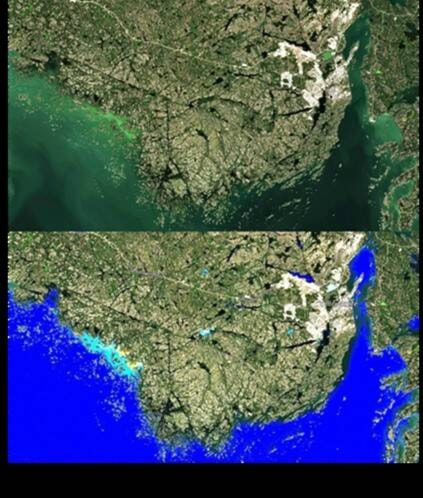A blue-green algae growing near Negus Point on Great Slave Lake is not toxic, the GNWT stated last week.
The aquatic substance was causing some people concern and actually resulted in a spill report being filed to the Department of Environment and Climate Change (ECC). The report describes “a blue/green milky substance with a mild odour but no gasoline/diesel smell — possibly from the old Esso location or a nearby vessel.”
After an examination of samples collected from the site, the territorial government confirmed it was a type of blue-green algae, but not one with microcystin toxins.
This form of algae — technically known as Dolichospermumhas — been observed occasionally south of Dettah and among the West Mirage Islands. It’s a natural part of the Great Slave Lake food web that has been present in the lake for many years, said Thomas Bentham, senior communications officer with ECC.
ECC suspects that a south wind helped blow the algae into Yellowknife Bay recently, and the slower outflow from Yellowknife River this year may have helped hold the water in place, allowing the algae to reach farther into the bay.
“The primary concern with a blue-green algal bloom is the potential for toxins as these can be harmful to people and pets. Lab results confirmed that all water samples to date have no detectable levels of microcystins in them. This is positive news,” said Bentham. “A secondary concern is more common with larger blooms in southern lakes where, when the algae die off, their decomposition uses up the dissolved oxygen in the water. Aquatic animals, such as fish and bugs, need oxygen to survive. This was a small-scale bloom, and oxygen levels in the water did not appear to be affected.”
Environment and Climate Change Canada (ECCC) spokesperson Nicole Allen said the same algae has been observed in Yellowknife Bay before.
“The short-lived and spatially-limited cyanobacteria bloom detected last week was not the first time blue-green algae has been found in Yellowknife. Blue-green algae has been observed in Yellowknife Bay as far back as 2013,” she said.
She added that cyanobacteria/algae-blooms in colder environments are not uncommon, including in winter, under ice.
Increasing temperatures, declining winds and sufficient nutrients can all contribute to algae blooms, but without closer study, it could be hard to determine specifically, according to Allen.
ECCC research has shown that warming trends and declining winds have resulted in a reduction of large-bodied diatoms and an increase in small-bodied cells. This shift is important to the Great Slave Lake food web as the large diatoms are a richer food source level than the smaller-bodied diatoms that can potentially impact the entire food web.
